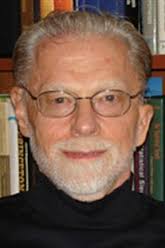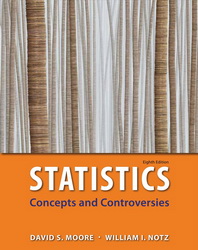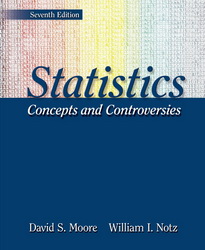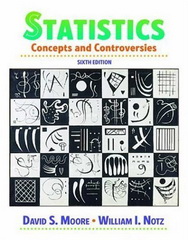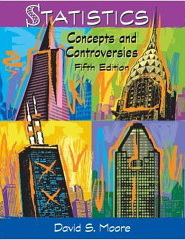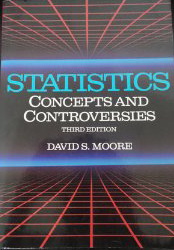Improving the Teaching of Statistics
David S. Moore is Shanti S. Gupta Distinguished
Professor of Statistics, Emeritus, at Purdue University and was 1998
president of the American Statistical Association. He received his A.B. from
Princeton and his Ph.D. from Cornell, both in mathematics. He has written
many research papers in statistical theory and served on the editorial
boards of several major journals. Professor Moore is an elected fellow of
the American Statistical Association and of the Institute of Mathematical
Statistics and an elected member of the International Statistical Institute.
He has served as program director for statistics and probability at the
National Science Foundation. In recent years, Professor Moore has devoted
his attention to the teaching of statistics. He was the content developer
for the Annenberg/Corporation for Public Broadcasting college-level
telecourse Against All Odds: Inside Statistics and for the series of video
modules Statistics: Decisions through Data.
Source:
http://www.whfreeman.com/catalog/Author/davidmoore
See also
David S. Moore
in Wikipedia.
David Sheldon Moore should not be confused with a David S. Moore: Professor of Developmental Psychology at Pfitzer College and Director, Claremont Infant Study Center
Interview with David Moore by Allan Rossman and E. Jacquelin Dietz. On statistics education for undergraduates (majors or not) and perhaps secondary school students: “little of real substance has changed in the past 20 years, the 1997 advent of AP Statistics being the most significant exception.” Journal of Statistics Education, Volume 21, Number 2 (2013).
A Generation of Statistics Education: An Interview with Frederick Mosteller by David S. Moore (JSE, 1993).
Per David Moore: “Please be aware that my texts are now other hands, all except Basic Practice and Essential Statistics for some time, even though they continue to bear my name. In one case (Exploring the Practice of Statistics) I had no involvement in preparing the text. Please direct text questions to the current authors.”
Concepts and Controversies by David Moore [and William Notz: 6th ed. onward]
Preface (3rd edition): This is a statistics book for readers interested in ideas rather than technique. It presents, in a non-technical form, the most important statistical concepts as they are applied in public policy, the human sciences, and everyday life. It is designed to give non-mathematical readers critical insight into the uses and misuses of numbers and quantitative arguments, which are increasingly prevalent in fields ranging from sociology to medicine to literary analysis. The goal is not to train statisticians, but to present statistics as a useful tool for clear thinking in personal and professional life. The third edition has been revised and updated, placing more emphasis on giving students hands-on experience with data. Chapters 4 and 5 have been reorganized into a more logical arrangement. Many new examples and exercises have been added. [This text refers to an alternate Paperback edition.]
STATISTICS EDUCATION ARTICLES by David Moore:
1988: “Should mathematicians teach statistics” (with discussion), College Mathematics Journal, 19, 3–7. doi:10.2307/2686686. JSTOR 2686686.
1995: Statistics Research: The Next Ten Years. TR95-9. Published in Statistics and Computing, Vol. 3, pp. 200–201, 1993. Copy
1995:
The Craft of Teaching.
MAA FOCUS 15 (1995) Number 2, 5–8.
Copy
Remarks on receiving the MAA's national award for college or university teaching.
“This is the closest I have come to the fashionable ‘statement of teaching philosophy.’”
1995:
Statistics Education Fin de Siècle.
Moore, Cobb, Garfield & Meeker.
TR95-10
The American Statistician 49 (1995), 250–260.
Copy
“Higher education faces an environment of financial constraints, changing
customer demands, and loss of public confidence. Technological advances may
at last bring widespread change to college teaching. The movement for
education reform also urges widespread change. What will be the state of
statistics teaching at the university level at the end of the century? This
article attempts to imagine plausible futures as stimuli to discussion. It
takes the form of provocations by the first author with responses from the
others on three themes: the impact of technology, the reform of teaching,
and challenges to the internal culture of higher education.”
1995: Social Statistics: Mathematics Meets Policy. TR95-14. D. S. Moore, V. Verma. UMAP Journal, Vol. 20, pp. 37–56, 2000. Copy
1996:
Multimedia for Teaching Statistics: Promises and Pitfalls.
Velleman and Moore.
TR95-13
The American Statistician 50(1996) 217–225
Copy
“Multimedia presentation combines text, sound, still images, full-motion
video, animation, and computer graphics in a single computer-based system.
The user interacts with the system via keyboard and mouse. Such systems have
considerable promise for teaching. In particular, they encourage constant
active participation by the learner and can adapt to individual differences
in preparation, pace, and learning style. This paper examines the
pedagogical (as opposed to technical) issues in using multimedia technology
for teaching statistics. It points to weaknesses as well as advantages, and
attempts to make clear what is known and what remains to be understood. It
argues that human teachers will remain essential to support the social
aspects of learning (especially motivation) and for assessing learning.”
1997:
Bayes for Beginners? Some Reasons to Hesitate.
TR93-33.
The American Statistician, 51 (1997), 254–261 and 272–274.
Copy
“Is it reasonable to teach the ideas and methods of Bayesian inference in a
first statistics course for general students? This paper argues that it is
at best premature to do so. Surveys of the statistical methods actually in
use in several fields suggest that Bayesian techniques are little used. A
reading of Bayesian texts and research suggests that Bayesians have not yet
agreed on standard approaches to standard problem settings. Finally, an
emphasis on Bayesian inference might well impede the trend toward experience
with real data and a better balance between data analysis, data production,
and inference in first statistics courses.”
1997:
Bayes for Beginners? Some Pedagogical Questions.
Advances in Statistical Decision Theory, Birkhäuser, Boston, 1997, 3–17.
Copy
“Dedicated to Shanti S. Gupta, chair of the Purdue Statistics Department
during most of my career. Ought we to base beginning instruction in
statistics for general students on the Bayesian approach to inference? In
the long run, this question will be settled by progress (or lack of
progress) in persuading users of statistical methods to choose Bayesian
methods. This paper, a companion to the one listed above, is primarily
concerned with the pedagogical challenges posed by Bayesian reasoning. It
argues, based on research in psychology and education and a comparison of
Bayesian and standard reasoning, that Bayesian inference is harder to convey
to beginners than the already hard reasoning of standard inference.”
1997:
New pedagogy and new content: the case of statistics.
TR96-37.
International Statistical Review, 65, 123–165.
Copy
“Statistical education now takes place in a new social context. In addition,
it is influenced by a movement to reform the teaching of the mathematical
sciences in general. At the same time, the changing nature of our discipline
demands revised content for introductory instruction, and technology
strongly influences both what we teach and how we teach. The case for
substantial change in statistics instruction is built on strong synergies
between content, pedagogy, and technology. Statisticians who teach beginners
should become more familiar with research on teaching and learning and with
changes in educational technology. The spirit of contemporary introductions
to statistics should be very different from the traditional emphasis on
lectures and on probability and inference.”
1997:
“Mathematics, Statistics, and Teaching”.
D. Moore and G. Cobb. American Mathematical Monthly, 104 (1997), 801–823.
“How does statistical thinking differ from mathematical thinking? What is
the role of mathematics in statistics? If you purge statistics of its
mathematical content, what intellectual substance remains? In what follows,
we offer some answers to these questions and relate them to a series of
examples that provide an overview of current statistical practice. Along the
way, and especially towards the end, we point to some implications for the
teaching of statistics.”
1997: Probability and Statistics in the Core Curriculum. TR95-11. Confronting the Core Curriculum, Dossey (ed.). MAA, 93–98. Copy
1997: Quality, Statisticians, and Universities. TR95-12. David S. Moore Purdue University S. Ghosh, W. R. Schucany and W. B. Smith (eds.) Statistics of Quality, Marcel Dekker, 1997, pp. 21–26. Copy
1998:
“Statistics among the liberal arts”
American Statistical Association 1998 Presidential Address, JASA, pp. 1253–1259
Copy
“The liberal arts are usually understood to be general and flexible modes of
reasoning. By this definition, statistics qualifies as a liberal art, and it
is important to the health of the discipline that it be recognized as such.
The ‘philosophical’ tradition of the liberal arts that is now dominant has
alternated with an ‘oratorical’ tradition that also gives insight, as do
ideas of ‘evolutionary psychology.’ This paper considers how understanding
statistics as a liberal art influences our appreciation of the discipline
and especially our teaching of beginners.”
1999: What Shall We Teach Beginners? Invited discussion of a paper by Wild and Pfannkuch. ISR 67 (1999), 250–252. Copy
1999:
Teaching Beginners as a Mirror of the Discipline.
Australian and New Zealand Journal of Statistics 41 (1999), 135–137.
Copy
Invited discussion of the Presidential Address by Professor Des Nichols.
2000:
Statistics and Mathematics: Tension and Cooperation.
Moore & Cobb. American Mathematical Monthly, 2000, pp. 615–630.
Copy
“The gradual distancing of statistics from mathematics, due mainly to the
fact that statistics has changed much more rapidly than mathematics, carries
risks for both disciplines. Statistics risks dissipating back into the many
fields from which it coalesced or being swallowed by broader information
technology. Mathematics risks following academic philosophy into irrelevant
profundity. In fact, statistics has cultural strengths that might greatly
assist mathematics, while mathematics has organizational strengths that can
provide shelter for academic statistics. Moreover, mathematics and
statistics are natural intellectual allies in the debate over the relative
roles of thought and automation. Increased cooperation between professional
societies could benefit both fields. We offer some specific suggestions for
such cooperation.”
2001:
Undergraduate Programs and the Future of Academic Statistics.
The American Statistician, 2001, pp. 1–6.
Copy
“This paper is the keynote address from a symposium, 'Opportunities in
Undergraduate Education' sponsored by the American Statistical Association
at the 2000 Joint Statistical Meetings. The paper offers background
information relevant to planning undergraduate programs in statistics and
some opinions based on this information.”
2005:
Preparing Graduate Students to Teach Statistics: Introduction.
The American Statistician, 2005, pp 1–3.
Copy
“This paper introduces a special section on preparing graduate students to
teach. It provides background and raises issues to keep in mind when reading
the papers that follow, which describe the teacher preparation programs of
several leading graduate departments.”
STAT-ED ABSTRACTS and SLIDES-ONLY:
1997: Statistical Literacy and Statistical Competence in the 21st Century. Slides [Ed, No definitions]
1998: Statistical Literacy and Statistical Competence in the 21st Century. MSMESB Univ. Iowa Abstract-only. “Educated people face a new environment at century's end: work is becoming intellectualized, formal higher education more common, technology almost universal, and information (as well as mis- and dis-information) a flood. In this setting, what is statistical literacy, what every educated person should know? What is statistical competence, roughly the content of a first course for those who must deal with data in their work? One might define competence as what we hope a business statistics student will retain five years later.”
1999: Statistics and Sound Bites: Statistical Literacy and the Internet US Census Bureau Slides Copy [Ed. No definitions]
2001: Statistical Literacy and Statistical Competence in the New Century. IASE slides IASE Korea Copy [Ed. No definitions]
2001: Statistical Literacy and Statistical Competence in the New Century. Literacy Slides Copy [Ed. Slightly different; No definitions]
In some of these slides, Professor Moore presented this challenge: “If the rocket goes up, I don't care where it comes down.” In 2013, when asked for an explanation, he said “The ‘If the rocket …’ line is from the classic Tom Lehrer song ‘Werner von Braun.’ In that context it referred to a technical expert being satisfied with technical success without regard for real world consequences or moral issues.”
Professor Moore also presented this challenge: “Does statistics have a core?” When asked for an explanation in 2013, he replied, “As you might guess, I have no idea what I said 12 years ago to accompany that line in the projected outline. Probably something like statistics in practice is more than technique.”
TECHNICAL ARTICLES by David Moore:
1968: Asymptotically nearly efficient estimators of multivariate location parameters (now in reprint form). TR68-10. Published in Annals of Mathematical Statistics, Vol. 40, pp. 1809–1823, 1969.
1968: Uniform consistency of some estimates of a density function. [TR68-99] E. G. Henrichon, D. S. Moore. Published in Annals of Mathematical Statistics, Vol. 40, pp. 1499–1502, 1969.
1969: Asymptotically nearly efficient procedures for bivariate location parameters. [TR69-99] Annals of the Institute of Statistical Mathematics, Vol. 22, pp. 41–49, 1970.
1969: A chi-square statistic with random cell boundaries. [TR-206] Published in Annals of Mathematical Statistics, Vol. 42, pp. 147–156, 1971.
1986: David S. Moore, Tests of chi-squared type, in Ralph B. D'Agostino and Michael A. Stephens, (eds.), Goodness-of-Fit Techniques, Marcel Dekker, New York, 1986, pp. 63–95.
1970: On multivariate chi-square statistics with random cell boundaries. [TR-236]
1970: Asymptotically efficient estimation by local-parameter approximations. Published in Annals of the Institute of Statistical Mathematics, Vol. 24, No. 2, pp. 299–308, 1972.
1972: A note on Srinivasan's goodness of fit test. [TR-293] Published in Biometrika, Vol. 60, pp. 209–211, 1973.
1975: A unified large-sample theory for chi-square statistics for tests of fit. D. S. Moore and M. C. Spruill. Published in The Annals of Statistics, Vol. 3, No. 3, pp. 599–616, 1975.
1976: Large sample comparison of tests and empirical Bayes procedures. J. C. Kiefer and D. S. Moore Published in On the History of Statistics and Probability, Editor D.B. Owen, Marcel Dekker, Inc., 1976, pp. 349–365.
Statistical Decision Theory and Related Topics, Editors. S.S. Gupta and D.S. Moore, New York: Academic Press, pp. 139–155.
1975: Variance comparison for unbiased estimators of probabilities of correct classifications. D. S. Moore, S. J. Whitsitt, D. A. Landgrebe. [TR-401] Published in IEEE Transactions on Information Theory, Vol. 22, pp. 102–105, 1976.
1975: Generalized inverse, Wald's method, and the construction of chi-square tests of fit. [TR-405] Published in Journal of the American Statistical Association, Vol. 72, pp. 131–137, 1977.
1977: Consistency properties of nearest neighbor density function estimators. D. S. Moore and J. Yackel. Published in The Annals of Statistics, Vol. 5, No. 1, pp. 143–154, 1977.
1977: Large sample properties of nearest neighbor density function estimators. D. S. Moore and J. W. Yackel. Published in Statistical Decision Theory and Related Topics, II, Editors S.S. Gupta and D.S. Moore, pp. 269–279, Academic Press, 1977.
1976: Recent developments in chi-square tests for goodness of fit. [TR-459]
1978: Chi-square tests. [TR-469] Published in Studies in Statistics, Editor R. Hogg, pp. 66–106, 1978.
1977: Chi-square tests of fit for type II censored data. D. P. Mihalko, D. S. Moore. [TR-505] Published in Annals of Statistics, Vol. 8, pp. 645–644, 1980
1978: Chi-square tests for multivariate normality with application to common stock prices. D. S. Moore and J. B. Stubblebine. [TR78-17] Published in Communications in Statistics, Vol. A10, pp. 713–738, 1980.
1980: The effect of dependence on chi-square tests of fit. [TR80-21] Published in Annals of Statistics, Vol. 10, pp. 1163–1171, 1982.
1982: The effect of dependence on chi-squared and empiric distribution tests of fit. L. J. Gleser, D. S. Moore. [TR82-21] Published in Annals of Statistics, Vol. 11, pp. 1100–1108, 1983.
1983: Measures of Lack of Fit From Tests of Chi-Squared Type. [TR83-12] Published in Journal of Statistical Planning and Inference, Vol. 8, pp. 151–166, 1984.
1983: Chi-Squared Tests of Fit — A Survey for Users. [TR83-53] Published in Goodness of Fit Techniques, Editors R. D'Agostini and M. A. Stephens, pp. 63–95, 1986.
1984: The effect of positive dependence on chi-squared tests for categorical data. L. J. Gleser and D. S. Moore. [TR84-20] Published in Journal of the Royal Statistical Society, Vol. B47, pp. 459–465, 1985.
1984: Positive Dependence in Markov Chains. L. J. Gleser and D. S. Moore. [TR84-22] Published in Linear Algebra and Applications, Vol. 70, pp. 131–146, 1985.
1986: Computers in statistical research. Statistical Science 1 (1986) 419–437 (with W. F. Eddy et al.).
1989: Power approximations to multinomial tests of fit. Journal of the American Statistical Association 84 (1989) 130–141 (with J. Oosterhoff et al.).
1989: Asymptotic error bounds for power approximations to multinomial tests of fit. Contributions to Probability and Statistics: Essays in Honor of Ingram Olkin. Springer, 1989, 385–402. (with J. Oosterhoff et al.).

